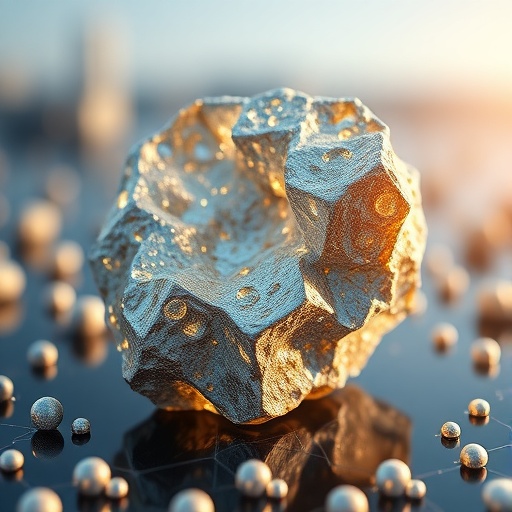Institute of Science Tokyo has made a groundbreaking advancement in hydrogen production through the development of potassium- and calcium-modified ilmenite oxygen carriers. Traditional methods of hydrogen production often involve substantial carbon emissions, making it challenging to produce clean hydrogen at scale. This new method pioneered by the researchers not only produces hydrogen but also captures carbon dioxide simultaneously, presenting a viable pathway towards carbon-neutral energy systems. The integration of these modified oxygen carriers into chemical looping processes represents a significant leap forward, enhancing efficiencies and production yields in hydrogen generation.
Chemical looping hydrogen production is an advanced energy conversion method that utilizes metal oxides as oxygen carriers to facilitate redox reactions without direct combustion. This process typically comprises three interconnected reactors—each serving a specific function: a fuel reactor that converts carbon monoxide to carbon dioxide, a steam reactor designed for hydrogen production, and an air reactor for generating electricity. Despite the natural potential of ilmenite as an oxygen carrier in these systems, its reactive properties have historically limited its application in industrial settings. The sluggish kinetics often observed with conventional ilmenite render it less efficient and less desirable for large-scale production.
To address these limitations, a team led by Professor Junichiro Otomo, along with Dr. Zhuang Sun, undertook the challenge of enhancing the reactivity of ilmenite through chemical modification. Focusing on the incorporation of calcium and potassium into ilmenite’s structure, the research investigated the thermodynamic properties and reaction kinetics of these modified carriers. The premise behind this modification lies in the observation that both calcium and potassium are abundant in biomass ash, suggesting that they would facilitate a more effective integration with renewable fuels, thus making the entire process of producing hydrogen more sustainable.
Through rigorous experimentation, the researchers employed a solid-state synthesis method to modify ilmenite’s structure. They initiated the process by treating natural ilmenite to eliminate impurities, resulting in a more reactive base for further enhancement. The subsequent blending of treated ilmenite with calculated amounts of calcium carbonate and potassium carbonate was performed in a controlled environment using a ball mill, followed by high-temperature calcination. This method not only altered the original structure of ilmenite but also introduced a calcium titanate phase, which contains iron substitutions.
The introduction of iron-doped calcium titanate within the ilmenite matrix is pivotal; it serves as an ionic and electronic conductor, significantly enhancing the capacity for redox reactions. This structure promotes the diffusion of oxide ions, resulting in an accelerated reaction rate that translates directly into improved hydrogen yields. The results from the research revealed that the optimized K-Ca co-modified ilmenite achieved a dramatic increase in hydrogen generation, skyrocketing production by approximately 440% while simultaneously reducing carbon monoxide consumption by 57%. This impressive performance signifies a transformative shift in the capabilities of chemical looping systems.
Additionally, the updated process shows substantial promise when evaluated within a polygeneration framework. By enabling simultaneous hydrogen production, carbon dioxide capture, and electricity generation, the overall efficiency of energy systems that adopt this methodology is expected to improve significantly. This is particularly relevant, as the optimization was achieved using a reactor that is just one-third the size of conventional setups, highlighting the potential for scalable application in commercial settings.
In forward-looking statements, the research team has expressed their intention to explore further optimizations, specifically focusing on developing lower-temperature synthesis methods that could lower operational costs significantly. This is not merely an academic endeavor, as a demonstration project is scheduled for July 2025, led by Osaka Gas Co., Ltd. and JFE Engineering Corporation in collaboration with the Japan Carbon Frontier Organization. The aim is to utilize this new material to achieve multi-faceted energy production from biomass and liquid waste sources efficiently.
Beyond these immediate applications, the Institute of Science Tokyo is also expanding its experimental capabilities through the Green Transformation Initiative. Their goal is to bolster research into polygeneration technologies. A large-scale fluidized bed reactor experiment is already underway, refining the practical aspects of this technology and aligning it for real-world applications. The team envisions that these developments will collectively contribute to a sustainable energy future, where hydrogen can be produced cleanly, efficiently, and reliably in synergy with carbon capture technology.
In summary, the research conducted by the Institute of Science Tokyo represents a substantial step forward in clean energy technology. By breathing new life into the traditional method of hydrogen production through advanced chemical engineering techniques, the researchers have laid the groundwork for future innovations that prioritize sustainability without sacrificing efficiency. This exciting development opens the door to a new era of energy production, one that aligns closely with global efforts to reduce carbon emissions and combat climate change.
As the world increasingly transitions towards renewable energy sources, this advancement in hydrogen production is timely. It reflects a growing trend in energy research aiming to find solutions that meet the dual challenges of energy demand and environmental sustainability—a crucial element for our planet’s future.
Subject of Research:
Article Title:
News Publication Date:
Web References:
References:
Image Credits:




